|
William
Walcot R.E., Hon.R.I.B.A.
(Odessa
1874 – 1943 Ditchling, Sussex)
An
Architect-Etcher and quintessential artist of
the Modern British Etching Boom.
Walcot
was a cosmopolitan. His father, an Englishman,
met and married his Russian mother, the daughter
of a wealthy landowner, while visiting that
country. Born in the Ukraine, close to the
Black Sea, Walcot’s childhood
was spent travelling with his parents in Spain,
South America, France (Bayonne and Bordeaux)
and Belgium until his mother and younger brother
returned to Russia and Walcot was sent to school.
He was educated at Amiens and then in Paris.
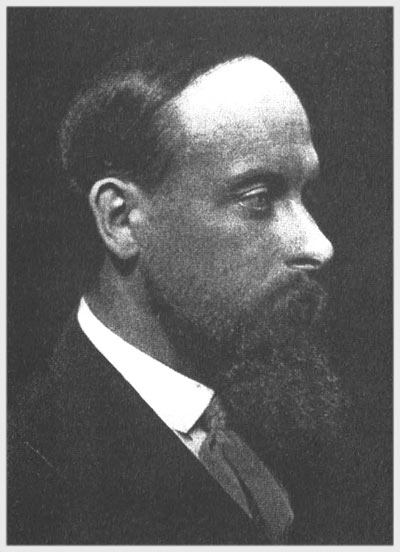 |
William
Walcot, c.1919
Photograph reproduced courtesy of the
publishers, H.C. Dickens, from their
monograph on the artist. |
Though
he went ‘home’ to Russia at the age
of 17, Walcot returned to France to study architecture
with Gaston Redon (the brother of Odilon), and
at the Beaux Arts. He completed his training
in Moscow at the Imperial Academy of Arts, graduating
in 1897, and practised as an architect in Moscow
(he was co-designer of the city’s Metropole
Hotel) until 1905. In 1904 in a sad interlude
he and his first wife, an Irish governess and
lady-in-waiting at the Russian court, went to
the Isle of Wight for her to convalesce from
tuberculosis, but she died there. This perhaps
motivated his ensuing permanent departure from
Russia. He settled in London in 1906.
Though
he would later work for the LCC planning department
and was made an honorary Fellow of the Royal
Institute of British Architects, Walcot did not
practise as an architect after he came to live
in England, though architecture remained his
love and inspiration. His successful employment
as an architectural perspectivist, envisioning
in presentation watercolours what a finished
building would look like from other architects'
plans, determined his career change to artist,
confirmed by the Fine Art Society commissioning
him in 1907 (as
they had Whistler nearly three decades earlier)
to visit Venice. The results of this trip were
exhibited at the FAS in the January 1908 one-man
show of Watercolours of London & Venice,
the first of five successive and successful annual/biennial
early shows with the Society. Watercolours
of London & Rome, in 1909, was followed
by Watercolours of London, Venice & Rome,
1910; Watercolours of Ancient Rome, London & Oxford 1912;
and Etchings by William Walcot in 1914.
Despite
the title of the first Fine Art Society exhibition, Watercolours
of London & Venice, the catalogue
entries include one etching The Library of
St. Marks and the 1912 show (Watercolours
of Ancient Rome, London & Oxford) included
two etchings among the exhibits, The Giudecca,
Venice and La Bacchante et le
jeune Faune. The 1910 catalogue had a notice
at the end that “An exhibition of Original
Etchings is now on view in the Lower Gallery”,
which may also have included Walcot etchings.
Over
the next two decades, essentially the years of
the British Etching Boom, etching was a prime
concern of Walcot.
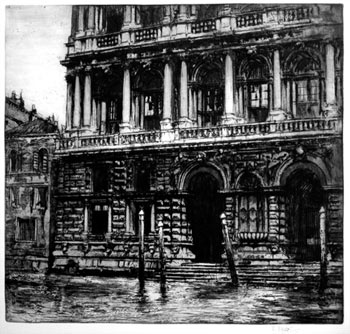 |
“Palazzo Pesaro”,
1913 |
Almost
all Walcot’s early exhibits at the Royal
Academy annual Summer shows, from his first participating
in 1908, were etchings. And it was his three
exhibits in 1913, Palazzo Pesaro, Venice; A
Tragedy by Sophocles in the days of Hadrian;
and At the House of a Patrician which
drew the attention of the publishers H.C. Dickins
and led to the rewarding contract with them which
continued until 1925.
Walcot’s
individual and unique style as an etcher was
developed without formal training. However
he
and Frank Brangwyn became close friends and it
was perhaps Brangwyn, Walcot’s senior by
seven years, who had already been an etcher for
seven years when Walcot arrived in London in
1906, who introduced his new friend to the medium.
Brangwyn, as would Walcot, also broke the accepted ‘canons’ of
Modern British etching to work on plates of unconventionally
large dimensions and used zinc rather than copper
for these large plates. Brangwyn too had been
born abroad and was widely travelled. He was
in Venice in 1907, perhaps to visit the Venice
Biennale where his large etching Santa Maria
della Salute (21¼ x 31¾ inches,
540 x 805 mm) had won a gold medal.
Walcot
too was a painterly etcher, concerned only with
the final effect of the plate, and who delighted
in large scale. Like Brangwyn he employed zinc
for his large plates, a metal both cheaper than
copper and easier to work. He defined the principal
lines of the composition in drypoint or etching
but created tone by a variety of means in addition
to aquatint, from roughening the surface of the
plate with a roulette or mezzotint rocker to
painting nitric acid directly onto selectively
grounded areas of the plate and exploiting foul
biting. Versatile, Walcot could also work on
miniature plates as small as only 2 or 3 inches.
All his smaller, more traditionally sized plates,
were etched on copper.
Several
of Walcot’s etchings relate to or are anticipated
by watercolours. The earliest plates, which tend
generally to be large, are more concrete than
the later often smaller works which are more
impressionist in style. In the early plates the
figures have feet while in the later ones what
one might define as an architect’s notational ‘shorthand’ curtails
the legs in points, the figures are not important
in themselves, they add life and give scale to
the buildings.
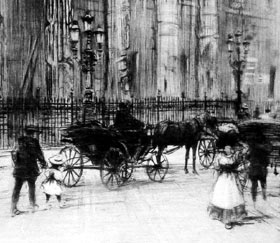 |
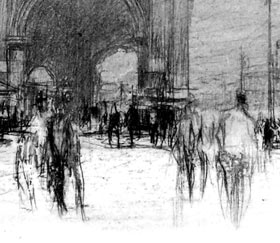 |
Detail
from “Piazza
di Pietra, Rome”
c.1908-10 |
Detail
from “Newcastle Central
Station”
1922 |
Finish
was disregarded when he felt he had successfully
conveyed a true impression of the view he was
seeking to express.
A
parallel impressionistic truth to the spirit
in creating convincing images of the living actuality
and atmosphere of ancient civilizations informed
Walcot’s Roman Compositions as
he categorised them, his pictorial ‘restorations’ of
ancient architectural ruins to functioning buildings.
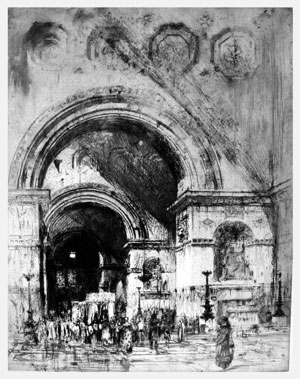 |
A
Court of Justice
|
Rome
in particular captured his imagination, a city
layered with cumulative architectural accretions
since Etruscan days. Walcot saw the ruins and
envisioned them in their original imperial splendour
and daily use by their inhabitants, in the same
way that he created watercolour architectural
perspectives for the architects of his own day,
Lutyens, Blomfield &co.; and indeed Salaman
records that Walcot made plans to scale of the
existing ruins from which to work. He saturated
himself in literary sources, Duruy’s Histoire
des Romains, Gibbon’s Decline & Fall
of the Roman Empire, the Letters of
the younger Pliny. He had a studio in the British
School at Rome and was party to the archaeological
scholarship and discoveries of the day. The Director
of the School of Rome, as well as writers and
historians Marius & Ian Ivor, W. R. Lethaby,
W. G. Newton, and Max Judge wrote learned articles
to accompany the illustrations of such large-scale
compositions as A Court of Justice; The
Atrium of the House of a Patrician; A
Tragedy by Sophocles; The Baths of Caracalla in
the Dickins 1919 monograph. Marius Ivor wrote
the Introduction to the 1918 James Connell & Sons
exhibition catalogue and commented “Archaeology
is history; art is experience, and must always
have reference to the modernity of the past”.
Walcot’s
delight in Rome was remembered by the architect
Percy Thomas PRIBA who recalled in the RIBA Journal
a holiday he had enjoyed with the artist when
he “spent several weeks with Walcot in
his beloved Rome. Whether it was exploring some
of the lesser known buildings and ruins, or jolly
dinner parties at the ‘Concordia’,
or trips to Frascati, where he persuaded a peasant
boy to sing in the ancient amphitheatre…”
Walcot’s
family told Timothy Lingard of Walcot’s
vivid imagination, believing himself reincarnated
from classical times and even dressing in a toga
and sandals at home and eating reclining on a
couch in the Roman manner. It is not surprising
that the French publisher Editions d’Art
Devambez commissioned him to etch the illustrations
to Flaubert’s Hérodias (a
biblical tale of Judaeo/Roman times) in 1928
and the same author’s Salammbô (set
in ancient Carthage) in 1936.
Several
of his distinguished contemporary etchers produced
plates that recorded their travels across The
Channel but Walcot’s “Roman Compositions” were
unique, both in their theme and scale. Brangwyn
etched large plates of Venice and elsewhere in
Italy, but usually bustling 20th century views
- and did not etch any Roman subjects.
Even
the main historical example, Piranesi, who was
equally passionate about Roman remains, and also
an etcher working on a monumental scale, recorded
the actuality of the ruins as he witnessed them
in the 18th century rather than imagining them
fully restored and functioning as buildings as
they would have appeared when originally built
in ancient times.
Walcot’s
one-man exhibitions were more occasional after
his contract with the publishers H.C. Dickins,
who both published and distributed the editions
to retail galleries. H.C. Dickins himself had
died in 1906 but the business was continued by
his two sons, Harold W. and Alec C., aged at
that date only sixteen and fourteen; and only
23 and 21 respectively in 1913 when they met
the 39 year old Walcot. During the period they
were associated, 1913-1924/5, Dickins issued
editions from at least 97 of Walcot’s
plates. Responding to demand edition sizes quickly
rose, from an average of 50 - 100 impressions
up to the end of the first World War, to 400 at
the peak of the Etching ‘Boom’ and
the height of Walcot’s success in the 1920’s.
Alec
Dickins married an American girl and settled
in New York where he opened the Dickins US office.
Harold Dickins escorted Walcot on a trip to
New York in 1923 where he etched at least a half
a dozen plates of Manhatten. The Dickins brothers
had been publishing additional editions for export
to the United States since the end of the First
World War.
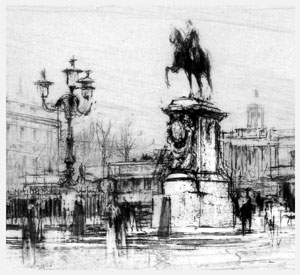 |
Detail
from “Trafalgar Square”, 1924.
One
of the five plates comprising
‘The
London Set’ |
There
had been a tradition for etchings to be published
in ‘sets’ which went back at least
to Whistler and is familiar from the oeuvre of
such as D.Y. Cameron, Lumsden etc. A number of
Walcot’s etchings were also issued this
way, the Edinburgh Set, 1918; the Venice
Set, 1920, the Arteries of Gt. Britain,
1922; the New York Set, 1923-4; the London
Set, 1924; and the Spanish Set,
1924-5. However, the individual plates within
a ‘set’ varied considerably in dimensions
and were sometimes published in consecutive years.
From the outset retail galleries usually sold
them as individual plates and today it is only
occasionally that a complete set is found still
together.
Though
one-man shows were less frequent than at the
outset of his career Walcot did continue to exhibit
throughout the Dickins years. Indeed he had a
major one-man show in April 1918 at the London
gallery of James Connell & Sons in Old Bond
Street Paintings, Watercolours & Etchings
by WW. The show included 40 etchings.
The
same year Walcot was elected an Associate of
the Royal Society of Painter-Etchers (RE); and
Fellow in 1920. The year 1919 saw the publication
of the folio monograph Architectural Watercolours & Etchings
of W. Walcot issued by H.C.Dickins (London & New
York) and Technical Journals Ltd (London).
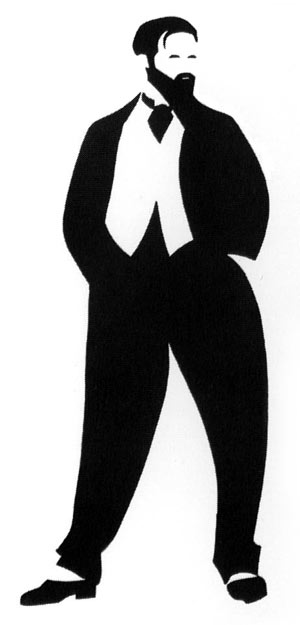 |
William
Walcot c.1921
A wood engraving by Robert Gibbins |
In
1919 the Fine Art Society showed Paintings & Watercolours
by William Walcot where “A collection
of Mr. Walcot’s Etchings will be shown
on application”. Paintings, Etchings & Watercolours
by WW followed five years later in 1924.
Meanwhile Walcot’s etchings are also catalogued
in several Fine Art Society group shows of the
period: Summer Exhibition of Original Etchings July-Sep
1922; Original Etchings by Fifty Artists
of Repute Dec 1922; Rare original Etchings
by Bone, Brangwyn, Cameron, Strang, Walcot, Whistler,
Zorn etc, May 1923; Original Etchings
by Leading Artists (a selection from the Society’s
portfolios) Nov 1923, Spring Exhibition
of Original Etchings by Leading Artists,
Nov 1924.
Walcot
also exhibited etchings regularly at the annual
salons of the R.E.; the R.A.; the Glasgow Institute
of Fine Arts; and the Walker Art Gallery, Liverpool.
These
years marked the height of the etching ‘boom’,
reflected in 1923 in the institution of the annual
volumes of Fine Prints of the Year. Walcot’s
etchings were illustrated that year, and in the
volumes for 1925, 1927 and 1928.
Following
the break with Dickins in 1925 Walcot had a one-man
show in December of that year at the Beaux Arts
Gallery, Bruton Place near Bond Street, Recent
Watercolours & Etchings by WW; with
a catalogue introduction by the well known critic
Konody. His etchings were also included in two
group shows at the Beaux Arts: Modern Etchings,
Oct 1926, and were to the forefront in Original
Engravings, Etchings, & Drypoints
by younger Contemporary Gravers in April-May
1929.
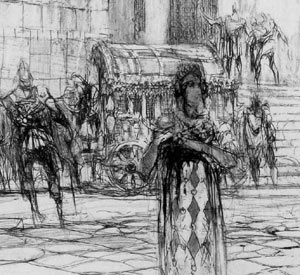 |
Detail
from “Antony’s Palace”,
1928 |
From
about 1927-1929 The Fine Art Society, who had
issued some of Walcot’s earliest etchings,
again took up publishing his recent plates. His
work was included in two group shows at the FAS Etchings by
leading Artists in December 1927
and Recent Etchings in October 1928.
Also in 1928 Walcot had his last one-man show
at the Society Impressions of Egypt. Pictures & Etchings
by William Walcot FRIBA, RE, in 1928. It
was particularly the Roman associations in ancient
Egypt which attracted Walcot and Antony in
Egypt, in particular, drew him again and
again as a theme.
With
the Wall Street Crash of 1929, and the ensuing
Depression in the 1930’s, the market for
etchings, which had developed a somewhat speculative
character, dwindled. Many etchers gave up the
technique entirely. The uncertain market is reflected
in Walcot’s exhibiting record. There were
no further shows of his etchings. His last exhibits
at the R.E. were in 1931 and after 1935 he is
no longer listed as a member. At the Royal Academy
Walcot showed his last etching in 1930. From
1931 to 1938, the final year he exhibited at
R.A., the exhibits are all drawings or paintings.
The two later Beaux Arts one-man shows in 1934 & 1937,
were respectively both devoted to, in the first
instance watercolours, and in the second, gouaches,
paintings of London.
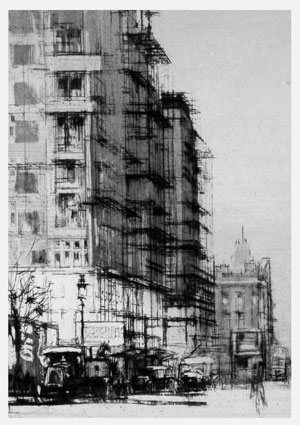 |
Scaffolding,
suggesting new buildings or
window replacement,
a detail from
“Marsham Street, Westminster”,
a Crittall commission for 1936 |
However
Walcot did continue to etch, if at a reduced
level, and was fortunate in finding two important
patrons of his etching in the 1930’s. Brothers,
Francis Henry Crittall (JP), who died in 1934,
and Sir Valentine, were eminent industrial engineers
and directors of the Crittall steel windows
construction company. First Francis Henry and
after his death Sir Valentine Crittall commissioned
annual etchings of London scenes for private
distribution to family, friends and clients at
Christmas. Henry Rushbury had benefited from
their patronage in the later 1920’s and
they commissioned at least six, and probably
nearer to ten, etchings from Walcot between 1930
and 1938. Several of these subjects include building
sites or recently erected buildings and one wonders
if perhaps these buildings had Crittall windows.
In
this difficult period Walcot also had work with
the LCC Department of Planning and eventually
received a civil list pension. In the 1940’s,
perhaps, as a reaction to the times, Walcot was
ill. Brangwyn put him up in a cottage in Ditchling
which he owned (the elderly Sir Frank Short would
be the next occupant) and visited him in the
evenings to relieve his mistress and his daughter
who watched over him to prevent his hurting himself.
In 1943 Walcot was transferred to the local hospital
where a fall from a window ended his life.
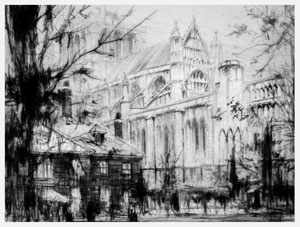 |
“Winchester”,
c.1920-23 |
This
collection of etchings, of which the majority
are from a single private collection, covers
the full range of Walcot’s etched work – architectural
views of the cities of New York, Vicenza, Venice,
Florence, Naples, Paris, Burgos, London, Oxford,
Cambridge, York, Winchester, Newcastle, Edinburgh
and his unique contribution to Modern British
etching - the reconstructed ancient Roman and
Egyptian ‘Compositions’.
The
paper on which Walcot’s etchings are printed
is mainly typical of the period. The large etchings
are on stout wove papers. The smaller etchings
are generally, in the earlier years, on fine
hand-made laid papers, superseded with the passage
of years by wove paper. Frequently there is no
watermark but certain impressions or in some
cases whole editions have manufacturers’ proprietory
watermarks. These are noted for individual impressions
in the catalogue entries. ‘Whatman’ paper
is usually also watermarked with the date of
its manufacture, which can be useful in some
instances for dating plates which are not recorded.
The etching itself will usually date to within
a couple of years of the watermarked date.
Most
of Walcot’s etching plates are not signed
but virtually all the impressions are signed
by him in pencil.
Walcot's
Signature
Illustrated
below are some examples of William Walcot's signature,
as it appears on a selection of his works. As
the years progressed his signature grew larger,
more florid, and less legible.
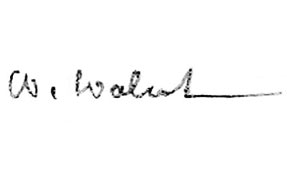 |
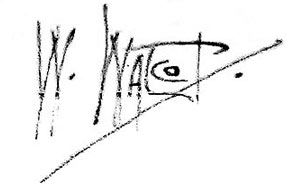 |
c
1908 |
c
1913 |
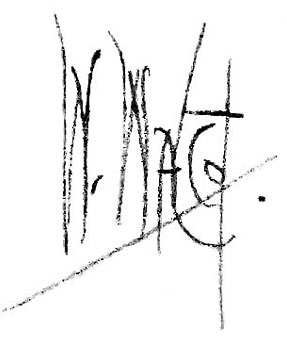 |
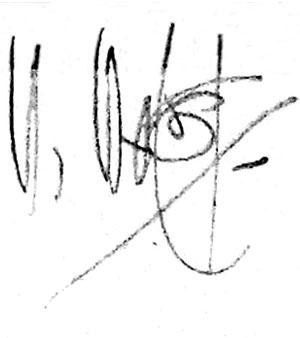 |
1920's |
1930's |
Catalogue
Raisonné
It
is intended to establish an on-going fully illustrated
e-Catalogue Raisonné of Walcot’s
etchings. This is currently a work-in-progress,
but can be viewed here.
In
the meanwhile, a printed exhibition catalogue
is available (Price £5 - see Catalogues section
for details) that provides the basis for this
enlarged Walcot web exhibition. Among appendices
at the back it provides an unillustrated chronological
listing of Walcot’s etched œuvre.
New acquisitions of etchings by Walcot will be
added into this exhibition even after it has been
archived.
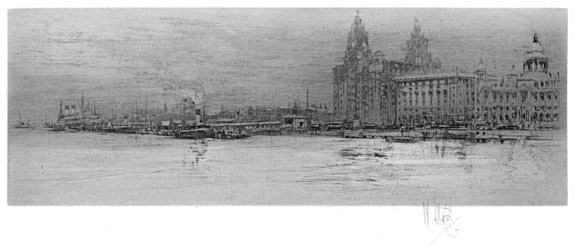
Return to the top ^
|
|
The
Exhibition
To
view the entire Exhibition, print-by-print,
click this link and
then follow the prints through the Gallery
by using the "next print >" and "< previous
print" navigation
buttons. Alternatively, you can select an individual
print from its thumbnail or title in the list
below.
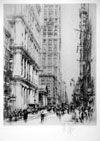 |
|
Lower
Broadway, New York
Etching,
1924 |
|
|
|
 |
|
Park
Avenue
Etching,
1923 |
|
|
|
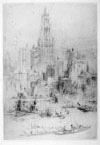 |
|
Downtown
Manhattan from the East River, with
a distant view of the
Woolworth Building
Etching and aquatint, 1924 |
|
|
|
 |
|
The
Remains of the Forum of Minerva,
Rome
Etching, 1908 |
|
|
|
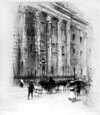 |
|
Piazza
di Pietra, Rome
Etching, 1908-10 |
|
|
|
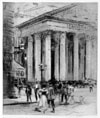 |
|
A
Corner of the Pantheon, Rome
Etching & Drypoint,
1914 |
|
|
|
 |
|
St Peter’s Rome
Etching & Drypoint,
1914 |
|
|
|
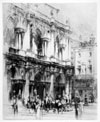 |
|
Vicenza
Etching and drypoint, c1925 |
|
|
|
 |
|
La
Rotonda
Etching, c1925 |
|
|
|
 |
|
The
Doge’s Palace
Etching and
drypoint, 1920 |
|
|
|
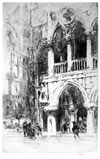 |
|
Doorway
to the Doge’s Palace
Etching
and drypoint, 1915 |
|
|
|
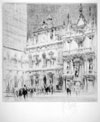 |
|
Venice – Courtyard
of the Doge’s Palace Etching
and drypoint, with aquatint |
|
|
|
 |
|
San
Marco, Venice
Etching & drypoint, 1920 |
|
|
|
 |
|
The
Library of St. Mark’s Venice
Etching, drypoint and aquatint, 1920 |
|
|
|
 |
|
Piazzetta,
San Marco, Venice
Etching & drypoint, 1914-19 |
|
|
|
 |
|
Giudecca
No.1, Venice
Etching & drypoint, 1913 |
|
|
|
 |
|
Giudecca
No.2, Venice
Etching, 1913 |
|
|
|
 |
|
Palazzo
Pesaro
Etching with aquatint, 1913 |
|
|
|
 |
|
The
Boatyard, Venice
Etching, 1914 |
|
|
|
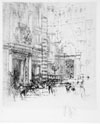 |
|
The
Baptistry, Florence
Etching with
aquatint, 1920 |
|
|
|
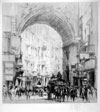 |
|
Arc
San Carlo, Naples
Etching & drypoint,
1921 |
|
|
|
 |
|
Café de
la Paix, Place de l’Opéra,
Paris
Etching, 1913 |
|
|
|
 |
|
L’Opéra,
Paris
Etching |
|
|
|
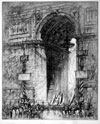 |
|
L’Arc
de Triomphe
Etching and aquatint,
1917 |
|
|
|
 |
|
The
Bull Ring, Seville
Etching & Drypoint,
1924 |
|
|
|
 |
|
Segovia
Bridge, Madrid
Etching, 1924 |
|
|
|
 |
|
Burgos
Cathedral
Etching & drypoint,
1924 |
|
|
|
 |
|
The
Forth Bridge
Etching, drypoint & aquatint, 1918 |
|
|
|
 |
|
The Arteries of Great Britain
Set of five etchings,
1922 |
|
|
|
 |
|
The
Clyde
Etching & aquatint, 1922 |
|
|
|
 |
|
The
Forth
Etching and drypoint, 1922 |
|
|
|
 |
|
The
Tyne
Etching and drypoint, 1922 |
|
|
|
|
|
|
 |
|
Newcastle
Central Station
Etching and drypoint,
two impressions, one hand coloured, 1922 |
|
|
|
 |
|
York
Minster – the West Front
Drypoint, 1923 |
|
|
|
 |
|
The
Mersey
Etching,
1922 |
|
|
|
 |
|
Winchester
Drypoint, 1923 |
|
|
|
 |
|
The
Ashmolean, Oxford
Drypoint, c1920-23 |
|
|
|
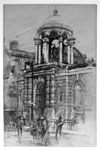 |
|
The
Entrance to Queen's College, Oxford
Etching & aquatint, c1910-13 |
|
|
|
 |
|
King’s
College, Cambridge
Etching and drypoint,
1916 |
|
|
|
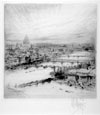 |
|
London
Etching and drypoint, 1920 |
|
|
|
 |
|
The
Thames
Drypoint & Etching, 1916 |
|
|
|
 |
|
The
Thames from Southwark Bridge Etching,
1916 |
|
|
|
 |
|
The
Thames from Waterloo Bridge Etching,
1916 |
|
|
|
 |
|
Changing
London
Euston Road at St Pancras
Etching, aquatint & rockerwork, 1937 |
|
|
|
 |
|
Marble
Arch
Etching, c1931 |
|
|
|
 |
|
The Quadrangle, Bart’s Hospital
Etching, drypoint & aquatint, 1938 |
|
|
|
 |
|
Corner of Berkeley Square
Etching and aquatint, c1935-7 |
|
|
|
 |
|
Fleet
Street
Etching, 1931 |
|
|
|
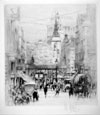 |
|
Ludgate
Hill
Etching, aquatint & drypoint,
1921 |
|
|
|
 |
|
St
Paul’s Cathedral – the North-West
corner of the West Front
Etching & drypoint,
1914 |
|
|
|
 |
|
St
Paul’s Churchyard
Etching & drypoint
with rockerwork |
|
|
|
 |
|
Cornhill
& Royal Exchange
Etching & drypoint, c1933-35 |
|
|
|
 |
|
The
Bank of England
Original etching |
|
|
|
 |
|
Covent
Garden
Original etching |
|
|
|
 |
|
The
Strand
Etching, 1924 |
|
|
|
 |
|
St
Mary-le-Strand
Original etching, 1913 or 1915 |
|
|
|
 |
|
Charing
Cross – The Statue of Charles I
Etching & drypoint,
1919 |
|
|
|
 |
|
Horseguards
Etching, 1924 |
|
|
|
 |
|
The
National Gallery &
St Martin’s-in-the-Fields
Etching & drypoint |
|
|
|
 |
|
Trafalgar
Square
Etching, drypoint & aquatint,
1924 |
|
|
|
 |
|
Trafalgar
Square (east side)
Etching, drypoint & aquatint,
1933 |
|
|
|
 |
|
Piccadilly
Circus
Etching, drypoint & ‘aquatint’,
c1920 |
|
|
|
 |
|
Regent
Street – the Quadrant
Etching,
1917 |
|
|
|
 |
|
Piccadilly
Circus & Glasshouse Street
Etching & aquatint,
c1933-35 |
|
|
|
 |
|
Marsham
Street, Westminster
Etching & aquatint,
1936 |
|
|
|
 |
|
Westminster
Abbey
Etching, drypoint & aquatint,
1919 |
|
|
|
 |
|
Westminster
Drypoint,
c1923 |
|
|
|
 |
|
Westminster
Bridge
Etching & aquatint |
|
|
|
 |
|
Chelsea
Old Church
Etching and drypoint,
1924 |
|
|
|
 |
|
The
Banqueting House, Whitehall
Etching
& drypoint |
|
|
|
 |
|
King
Charles in Whitehall
Etching with
aquatint, c1929 |
|
|
|
 |
|
The
Trial of David III before Edward I, Parliament
of Shrewsbury, 1283
Etching & aquatint, 1934 |
|
|
|
 |
|
Kom
Ombo
Drypoint, etching & aquatint,
1928 |
|
|
|
 |
|
The
Caravan
Drypoint, etching & aquatint,
1928 |
|
|
|
 |
|
The
Temple of Edfu
Etching, drypoint and aquatint, 1928 |
|
|
|
 |
|
The
Sacred Fair, Egypt
Etching,
drypoint & aquatint, c1918 |
|
|
|
 |
|
Caesar
in Egypt
Etching, drypoint & aquatint, c1926 |
|
|
|
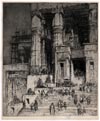 |
|
Antony
in Egypt
Etching, drypoint & aquatint, c1926 |
|
|
|
 |
|
Antony’s
Palace
Etching, drypoint & aquatint, 1928 |
|
|
|
 |
|
Romans
in the Forum
Etching, 1917 |
|
|
|
 |
|
The
Frigidarium of the Baths of Caracalla
Etching, drypoint & aquatint, 1918 |
|
|
|
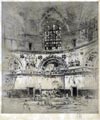 |
|
The
Caldarium of the Baths of Caracalla
Original etching & aquatint, c1915-19 |
|
|
|
 |
|
A Performance in the Colosseum
Original etching with
drypoint & aquatint, 1916 |
|
|
|
 |
|
A Tragedy of Sophocles
Original etching with
drypoint & aquatint, 1916 |
|
|
|
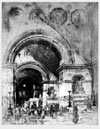 |
|
A
Court of Justice
Etching, drypoint & aquatint, 1913 |
|
|
|
 |
|
The
First Wooden Temple of Jupiter or Restoration
of one of the first Temples of Jupiter
Capitolinus, Rome
Etching, drypoint & aquatint,1918 |
|
|
|
 |
|
Villa
Quintilii
Drypoint, etching & aquatint,
1921 |
|
|
|
 |
|
The
House of Sallust
Etching, drypoint & aquatint,
1920 |
|
|
|
 |
|
Temple
of Romulus
Etching & aquatint,
1927 |
|
|
|
 |
|
The
(so-called) Stadium of Domitian
on the
Palatine Hill
Etching, drypoint & aquatint, 1919 |
|
|
|
 |
|
Atrium
of the House of a Patrician
Etching, drypoint & aquatint, 1915 |
|
|
|
 |
|
The
Emperor Hadrian entering Salonica Etching,
drypoint & rockerwork, 1918 |
|
|
|
 |
|
The Trojan Horse
Original etching & aquatint, 1914. |
|
|
|
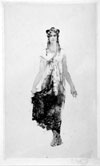 |
|
A
Greek Lady
Drypoint and aquatint,
with etching and rockerwork, 1913 |
|
|
|
 |
|
Babylon
Etching & aquatint, 1918 |
|